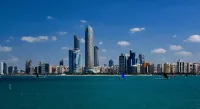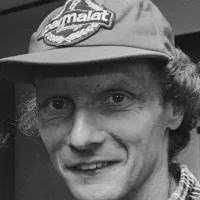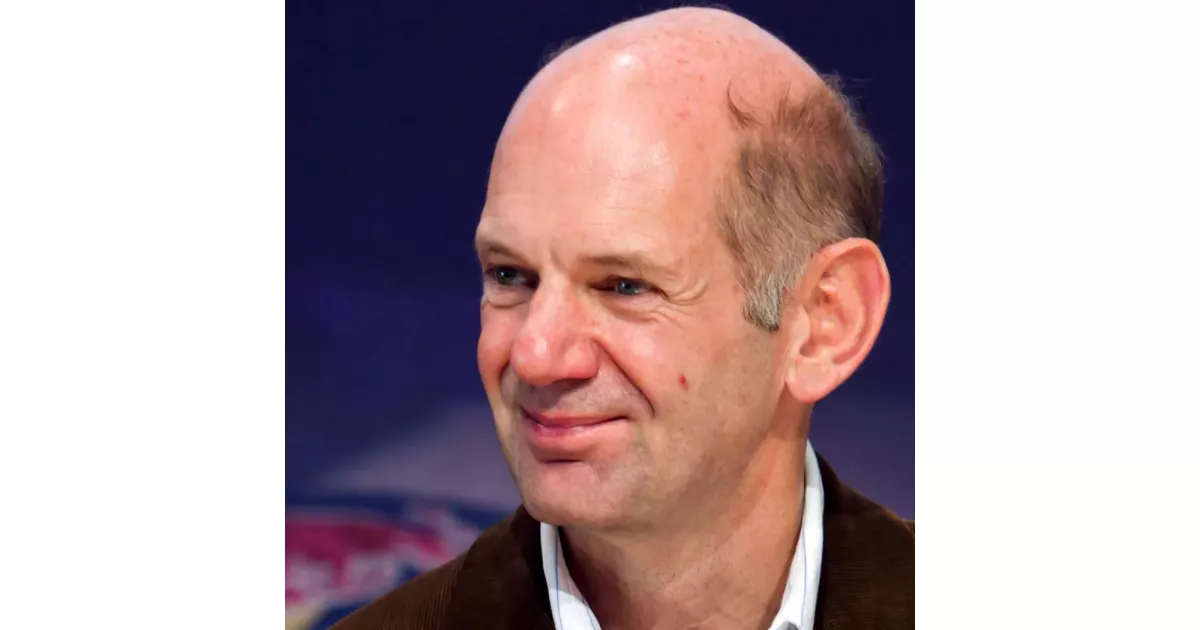Adrian Newey is a highly acclaimed British engineer and aerodynamicist in Formula One. Known for his innovative designs, Newey has been instrumental in numerous championship victories, contributing to 14 Drivers' and 12 Constructors' titles across teams like Williams, McLaren, and Red Bull Racing. He is widely regarded as one of the greatest engineers in Formula One history. He is currently technical director and co-owner of Aston Martin in Formula One and will be assuming the role of team principal from 2026.
December 1958: Adrian Newey's Birth
In December 1958, Adrian Martin Newey was born in Colchester, Essex, England, to Richard and Edwina Newey.
December 1958: Birth of Adrian Newey
In December 1958, Adrian Martin Newey was born. He is a British engineer, aerodynamicist, automotive designer, and motorsport executive.
1980: Graduation from University of Southampton
In 1980, Adrian Newey obtained a first class honors degree in Aeronautical Engineering from the University of Southampton.
1981: Joined March team
In 1981, Adrian Newey joined the March team.
1983: Married first wife Amanda
In 1983, Adrian Newey married his first wife, Amanda, a nurse, and they had two daughters.
1983: IMSA Title Win
In 1983, Adrian Newey's March 83G sports car design won the IMSA GT Championship title.
1984: Moved to March Indy Car Project
In 1984, Adrian Newey moved to the March Indy car project, working as designer and race engineer for Bobby Rahal at Truesports.
1984: IMSA Title Win
In 1984, Adrian Newey's March 83G sports car design won the IMSA GT Championship title.
1985: CART Championship and Indianapolis 500 Wins
In 1985, Adrian Newey's March 85C design won the CART championship with Al Unser, and the Indianapolis 500 with Danny Sullivan.
1985: CART Title Win
In 1985, Adrian Newey's designs won the CART title.
1986: CART Championship and Indianapolis 500 Wins
In 1986, Adrian Newey's March 86C design won the CART championship and Indianapolis 500 with Bobby Rahal.
1986: CART Title Win
In 1986, Adrian Newey's designs won the CART title.
1987: Re-hired by March
In 1987, after a stint at Newman-Haas, Adrian Newey was re-hired by March to work in Formula One as chief designer.
1988: First Formula One Design
In 1988, Adrian Newey's first Formula One design, the March 881, showed unexpected competitiveness, with Ivan Capelli finishing second in Portugal.
1988: McLaren MP4/4 record
In 1988, the McLaren MP4/4 set a win record of 93.8% which was later beat in 2023.
1989: Separation from first wife
In 1989, Adrian Newey and his first wife Amanda separated.
1990: Promotion to Technical Director at Leyton House Racing
In 1990, Adrian Newey was promoted to technical director as March became Leyton House Racing and later fired in the summer after a decline in the team's results.
1991: FW14 Chassis
By mid-season 1991, Adrian Newey's FW14 chassis was a match for McLaren, however, reliability issues prevented Nigel Mansell from winning the title.
1991: Start of Williams career
From 1991, Adrian Newey's cars secured 59 race victories, 78 pole positions, and 60 fastest laps all from 114 races from 1991 until 1997. These seven years saw four drivers clinch World Championship titles.
1991: First Grand Prix Win
In 1991, Adrian Newey's designs began winning Grands Prix. His designs have secured 223 Grand Prix victories between 1991 and 2024.
1992: Married second wife Marigold
In 1992, Adrian Newey married his second wife, Marigold, and they had a daughter, and son Harrison.
1992: First Constructors' Title
In 1992, Adrian Newey secured his first Constructors' title, with Nigel Mansell taking the Drivers' title.
1993: Second Constructors' Title
In 1993, Adrian Newey's FW15C helped Alain Prost secure the Drivers' title, resulting in his second Constructors' title.
1994: Dip in Performance and Senna's Death
In 1994, Adrian Newey-designed cars saw a performance dip, and the team struggled to match Schumacher. Ayrton Senna died at the San Marino Grand Prix that year. Despite this, Williams claimed their third straight Constructors' title.
1994: Death of Ayrton Senna
In 1994, Ayrton Senna died at the San Marino Grand Prix in a car that Adrian Newey helped to design, leading to manslaughter charges against Newey and other members of the Williams team.
1995: Ready to become technical director
In 1995, it became clear that Adrian Newey was once more ready to become technical director of a team.
1996: Gardening Leave
By the time Damon Hill and Jacques Villeneuve secured both titles in 1996, Adrian Newey had been placed on gardening leave prior to joining McLaren.
December 1997: Newey acquitted of manslaughter charges
In December 1997, Adrian Newey was acquitted of manslaughter charges following the death of Ayrton Senna at the 1994 San Marino Grand Prix in a car that Newey helped design.
1997: End of Williams career
From 1991, Adrian Newey's cars secured 59 race victories, 78 pole positions, and 60 fastest laps all from 114 races from 1991 until 1997. These seven years saw four drivers clinch World Championship titles.
1997: Improvement on MP4/12 Design
In 1997, Adrian Newey was unable to influence the design of the McLaren MP4/12 and focused on improving Neil Oatley's design while concentrating his efforts on the 1998 car.
1998: Titles Followed
In 1998, titles followed with the McLaren MP4/13.
November 1999: Acquittal upheld on appeal
In November 1999, Adrian Newey's acquittal was upheld on appeal regarding the manslaughter charges related to Ayrton Senna's death in 1994.
1999: Titles Followed
In 1999, titles followed with the McLaren MP4/14, and Mika Häkkinen narrowly missed out on a third Drivers' title in 2000.
2000: Titles Followed
In 1999, titles followed with the McLaren MP4/14, and Mika Häkkinen narrowly missed out on a third Drivers' title in 2000.
2000: Harrison Newey participates in Formula 2000 Championship
In 2000, Harrison Newey participates in Formula 2000 Championship.
2001: Contract with Jaguar F1 Team
In 2001, Adrian Newey signed a contract with the Jaguar F1 team, but the deal was not completed due to Ron Dennis persuading Newey to stay with McLaren.
January 2003: Case re-opened by Italy's Supreme Court
In January 2003, Italy's Supreme Court of Cassation re-opened the manslaughter case against Adrian Newey, citing "material errors."
2004: Uncertain Future at McLaren
In late 2004, Adrian Newey's future at McLaren became uncertain, with speculation of a return to Williams or leaving the sport.
April 2005: Contract Extension
In April 2005, Adrian Newey's contract with McLaren was extended by six months, with expectations of a sabbatical or retirement from Formula One design.
May 2005: Newey given full acquittal
In May 2005, Adrian Newey was given a full acquittal by Italy's Supreme Court of Cassation in the manslaughter case related to Ayrton Senna's death.
November 2005: Joining Red Bull Racing
On November 8, 2005, Red Bull Racing announced that Adrian Newey would join the team from February 2006.
February 2006: Joining Red Bull Racing
On November 8, 2005, Red Bull Racing announced that Adrian Newey would join the team from February 2006.
2006: Staying with McLaren
In 2006, Adrian Newey announced he would remain with McLaren for the year.
2006: Ford GT40 destroyed
In 2006, Adrian Newey destroyed a Ford GT40 while competing in the Le Mans Legend races, but escaped with only a cut finger.
2006: Move to Red Bull
In 2006, Adrian Newey moved to Red Bull after designing championship-winning Formula One cars for Williams and McLaren.
2007: Joined Red Bull Racing
In 2007, Adrian Newey joined Red Bull Racing.
2007: 24 Hours of Le Mans
In 2007, Adrian Newey transitioned to modern racing, joining the driver line-up in the AF Corse Ferrari F430 for the 24 Hours of Le Mans, finishing 22nd overall and fourth in class.
2007: Red Bull Achievements
In 2007, Adrian Newey's Red Bull car (RB3) was powered by the Renault RS26 engine. Despite reliability issues, Red Bull achieved fifth place in the Constructors' Championship.
2008: Intricate Design of RB4
In 2008, Adrian Newey and Geoff Willis noted that the RB4 chassis was the most intricate design from their factory. The season started well but declined in the second half.
2009: Large Step Up in Performance
In 2009, the RB5, which was designed by Adrian Newey, represented a large step up in performance for the team, achieving one–two finishes at Shanghai and the British Grand Prix.
June 2010: Collaboration on Gran Turismo 5
On June 15, 2010, during the Sony E3 Electronic Entertainment Expo, it was revealed that Adrian Newey collaborated as the chief technical officer for the video game Gran Turismo 5 for the PlayStation 3.
July 2010: Rewarded with his own Red Bull RB5
On July 2, 2010, Adrian Newey was rewarded with his own Red Bull RB5 in recognition of his achievements with Red Bull Racing since joining the team in 2007, and he first drove the car at the 2010 Goodwood Festival of Speed.
August 2010: Accident at Ginetta G50 Cup
On August 8, 2010, Adrian Newey was involved in an accident while participating in the Ginetta G50 Cup at the Snetterton circuit as a guest driver, sustaining a heavy side-on impact and being taken to hospital for checks.
November 2010: Constructors' Championship
On November 14, 2010, Red Bull won the Constructors' Championship. Adrian Newey became the only Formula One designer to have won Constructors' Championships with three different teams.
2010: Formula One Titles
From 2010 to 2013, Adrian Newey's cars secured consecutive Formula One Drivers' and Constructors' titles for Red Bull.
2010: Start of Four Consecutive Constructors' Titles
From 2010, Adrian Newey-designed chassis won four consecutive Constructors' titles with Red Bull, ending in 2013.
2010: Separation from second wife
In 2010, Adrian Newey and his second wife Marigold separated.
2011: Dominance of RB7
In 2011, the RB7 built on the RB6's speed and proved to be reliable, making it the clearly dominant car. Red Bull won the World Drivers' Championship on 9 October and secured the Constructors' Championship on 16 October at the Korean Grand Prix.
2012: Championship Win
In 2012, Red Bull and Vettel claimed the championship at the Brazilian Grand Prix.
2013: Formula One Titles
From 2010 to 2013, Adrian Newey's cars secured consecutive Formula One Drivers' and Constructors' titles for Red Bull.
2013: Red Bull last Constructors' Championship until 2022
In 2013, before 2022, Red Bull secured their first Constructors' Championship.
2013: World Championships
In 2013, the RB9 and Vettel dominated the field after the summer break to defend both the World Drivers' and World Constructors' Championship.
2013: End of Four Consecutive Constructors' Titles
Until 2013, Adrian Newey-designed chassis won four consecutive Constructors' titles with Red Bull, starting in 2010.
June 2014: Contract Extension
On June 8, 2014, Red Bull Racing announced that Adrian Newey had extended his contract for the next few seasons, giving him a wider responsibility including "new Red Bull Technology projects".
2014: Renault power units held back Newey's cars
In 2014, after the introduction of V6 turbo-hybrid power units, Adrian Newey's cars faced performance limitations due to the Renault power units. The RB10 took second place in the 2014 Constructors' Championship.
2015: RB11 wins at least two Grands Prix
In 2015, the RB11 designed by Adrian Newey and driven by Daniel Ricciardo and Daniil Kvyat won at least two Grands Prix.
2016: Son Harrison wins MRF Challenge Formula 2000 Championship
In 2016, Adrian Newey's son, Harrison, won the 2016–17 MRF Challenge Formula 2000 Championship.
2016: RB12 takes second place
In 2016, the RB12 designed by Adrian Newey secured second place in the Constructors' Championship.
August 2017: Married Amanda Smerczak
In August 2017, Adrian Newey married Amanda "Mandy" Smerczak, the daughter of South African actor Ron Smerczak.
October 2018: Advisory board member of the W Series
On October 10, 2018, Adrian Newey was announced as an advisory board member of the forthcoming W Series, a racing championship for women based on Formula 3-homologated Tatuus T-318 chassis.
2019: Switch to Honda power
In 2019, a switch to Honda power units provided Adrian Newey's team with the capability to compete for titles.
2020: RB16 takes second place
In 2020, the RB16 designed by Adrian Newey secured second place in the Constructors' Championship.
2021: Drivers' Championship win with RB16B
In 2021, Adrian Newey's RB16B design led the team back to title contention, resulting in Max Verstappen winning the Drivers' Championship.
2021: Drivers' Championship
In 2021, Adrian Newey's designed cars won the Formula One Drivers' Championship.
2022: Drivers' and Constructors' Titles
In 2022, Adrian Newey's designed cars won both the Formula One Drivers' and Constructors' titles.
2022: RB18 wins Drivers' and Constructors' Championships
In 2022, the RB18, designed by Adrian Newey, proved to be a strong contender, securing Max Verstappen's second Drivers' Championship at the Japanese Grand Prix and Red Bull's first Constructors' Championship since 2013.
2023: RB19 Dominance
In 2023, Adrian Newey's RB19 became one of the most dominant Formula One cars in history, achieving a win rate of 95.45%.
2023: Drivers' and Constructors' Titles
In 2023, Adrian Newey's designed cars won both the Formula One Drivers' and Constructors' titles.
2023: Red Bull's 100th Win and Newey's 200th Win
In 2023, at the Canadian Grand Prix, Max Verstappen achieved Red Bull's 100th win, which also marked Adrian Newey's 200th win in Formula One. Also in 2023, Red Bull broke McLaren's record of 11 consecutive victories by winning in Hungary, and at Monza, Verstappen broke Vettel's record of 9 consecutive wins, marking the 15th in a row for Red Bull.
April 2024: Reports of Newey's potential departure from Red Bull
On April 25, 2024, media outlets reported Adrian Newey's potential departure from Red Bull, with Red Bull Racing stating that he is contracted until at least the end of 2025. Five days later in April 2024, reports suggested Newey's departure was complete, with an official announcement expected before the Miami Grand Prix.
May 2024: Departure from Formula One Design Duties
On May 1, 2024, Red Bull Racing announced that Adrian Newey would immediately leave his day-to-day Formula One design duties to focus on the RB17 hypercar.
September 2024: Newey signs contract with Aston Martin
In September 2024, Adrian Newey signed a contract with Aston Martin, becoming a shareholder and Managing Technical Partner for the team.
2024: Recognition as one of the greatest engineers
As of 2024, Adrian Newey-designed chassis have won 12 World Constructors' Championships and 14 World Drivers' Championships, making him widely recognized as one of the greatest engineers in Formula One.
2024: Continued Grand Prix Wins
By 2024, Adrian Newey's designs had achieved 223 Grand Prix victories since 1991, showcasing his enduring impact in Formula One.
March 2025: Newey to officially start work at Aston Martin
On March 1, 2025, Adrian Newey is set to officially begin his work at Aston Martin, in time for the 2026 regulations.
November 2025: Newey to become Team Principal at Aston Martin
In November 2025, it was announced that Adrian Newey will take over the role of Team Principal at Aston Martin in 2026, replacing Andy Cowell.
2025: Newey to step away from Formula One duties
In 2025, Adrian Newey left Red Bull Racing during the first quarter and stepped away from his Formula One duties, while still working on their first hypercar, the RB17.
2025: Technical Director and Co-owner of Aston Martin
In 2025, Adrian Newey started serving as the technical director and co-owner of Aston Martin in Formula One.
2025: Full Departure from Red Bull
In the first quarter of 2025, Adrian Newey fully left Red Bull Racing.
2026: Team Principal of Aston Martin
From 2026, Adrian Newey will assume the role of team principal of Aston Martin.
2026: Newey to be Team Principal at Aston Martin
In 2026, Adrian Newey will take over the role of Team Principal at Aston Martin.
Mentioned in this timeline
Germany officially the Federal Republic of Germany is a Western...

Abu Dhabi is the capital city of the United Arab...

Niki Lauda was an Austrian Formula One driver and aviation...

A car also known as an automobile is a wheeled...

The jaguar is a large cat species native to the...

Fernando Alonso is a highly accomplished Spanish racing driver currently...
Trending

5 minutes ago James Van Der Beek auctions items amid wife Kimberly's cancer; spends Thanksgiving with family.

5 minutes ago Katy Perry joins Justin Trudeau in Tokyo for dinner and Sumo match.
5 minutes ago James Madison Dukes defeat NC Central Eagles; women win against East Carolina.

6 minutes ago Billy Napier Hired as James Madison's Head Coach: Return to Sun Belt
1 hour ago Rubrik's Stock Rockets After Q3: Revenue Surges, Outlook Brightens, Losses Shrink
2 hours ago Marathon Training Emotions, 2026 Boston Marathon Jacket Unveiled: A Story of Redemption
Popular
Aftyn Alyssa Behn is an American politician currently serving as...
Matt and Ross Duffer known as the Duffer Brothers are...

Lane Kiffin is an American football coach currently serving as...

XXXTentacion born Jahseh Dwayne Ricardo Onfroy was a controversial yet...

Stranger Things created by the Duffer Brothers is a popular...

William Franklin Graham III commonly known as Franklin Graham is...

